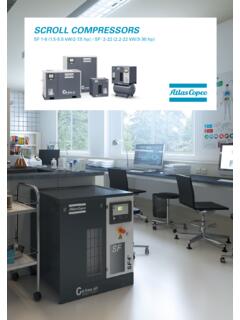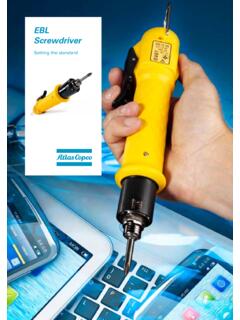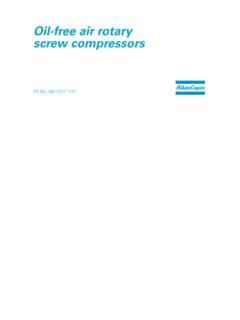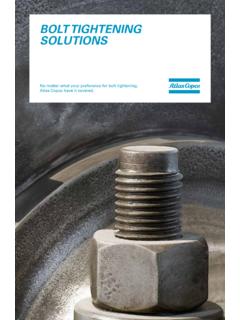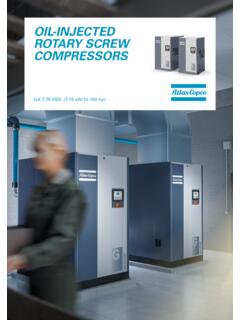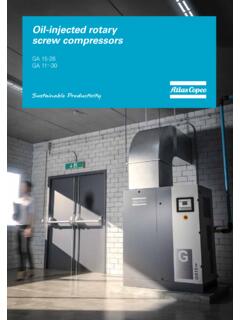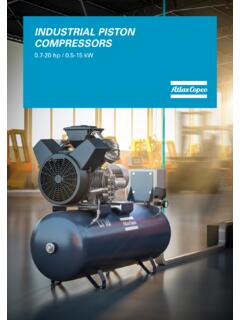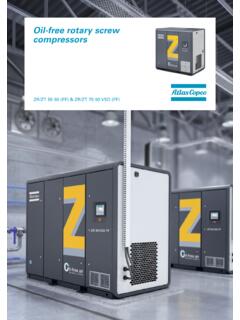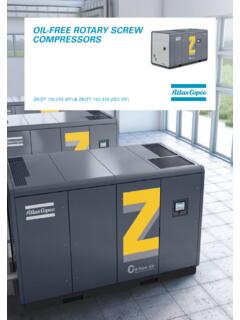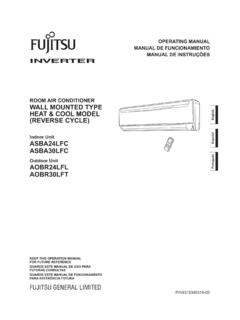Transcription of Compressed air drying - Atlas Copco
1 White paperCompressed air drying3 Table of contentIntroduction 4 Where does the water come from? 5 How to remove the water? 6 drying methods 7 Refrigerant dryers 9 Adsorption dryers
2 10 Rotary drum dryers 13 Membrane dryers 14 Conclusion 15 White paper : Compressed air drying4 IntroductionMany tools and equipment, driven by Compressed air, cannot withstand water or mois-ture. Many processes, using Compressed air, are processing products which cannot withstand water or moisture.
3 Inherent to the compression cycle, free water is often formed in the Compressed air circuit. Free water in a Compressed air system often causes corrosion which leads to rust form-ing in the Compressed air system. Those rust particles will be released and transported through the Compressed air system. This can result in damage or failure of the com- pressed air tools and can cause contamination of the processed products. Free water or moisture in a Compressed air system can sustain bacteria growth or the moisture can be adsorbed by the processed product leading to quality deviations and product does the water come from?
4 Atmospheric air always contains water, most of the times as vaporized moisture, some-times as free water (when it rains). The water vaporized in the atmosphere is most of the times not visible or notable. Air at a temperature of 35 C can contain a maximum of 39 grams water per m of air in the form of vapor, with 39 g/m the air has a relative humidity of 100%. If there is more water present in the air, excess of water condenses into droplets and not into vapor. When the temperature of the air decreases, the amount of water which can be con-tained as vapor is decreasing as well air at a temperature of 20 C can contain max.
5 17 grams of water per m of air as vapor. This means if we take 1m of air at 35 C with 100% relative humidity and we cool this down to 20 C, there will be 22 grams of free water formed. The dew point is a parameter which is often used to measure the dryness of the air, air at 35 C containing 39g of water vapor per m , which is 100% relative humidity, has a dew point of 35 C. Air at 35 C containing 22g of water vapor per m of air has a relative hu-midity of 56% and a dew point of 20 C. When these values are measured at atmospheric pressure, we talk about the atmospheric dew point.
6 When these values are measured under pressure we talk about pressure dew point. When atmospheric air is Compressed , the concentration of water vapor increases with the pressure ratio. At a normal ambient condition 35 C and a relative humidity of 60% there is approx. 23 grams of water per m of air as vapor. When compressing the ambient air from atmospheric pres-sure up to 7 bar (g), the concentration of water vapor increases 8 times. So per m of Compressed air there is 184 grams of water. This means per m of Compressed air leaving the compres-sor at 35 C 145 grams of free water is entering the Compressed air system.
7 A 90kW compressor, working 8 hrs. per day, delivers up to 970m com- pressed air during those 8 hrs., re-sulting in 140 liters of water every day entering the Compressed air system!Besides the free water, also water vapor is entering the Compressed air system, 39 grams per m , this results in more than 37 liters of water as vapor entering the com- pressed air system every to remove the water?There are several ways to remove water and moisture from Compressed air. The first method is overcompression, the pressure is increased to a lev-el above the required Compressed air pressure and at this higher pressure the free water droplets are removed.
8 In the next step, the pressure is decreased to the required Compressed air pressure. From this stage, only water vapor is present in the Compressed air, the relative humidity dropped below 100%. A second method is cooling, the Compressed air is cooled down to a lower tem-perature. At this lower temperature, the relative humidity exceeds 100% and free water droplets are formed. Those free water droplets are collected and removed. In the next step the temperature of the Compressed air is increased again.
9 From this stage, only water vapor is present in the Compressed air, the relative humidity dropped below 100%. As third method chemical drying is often used, the moisture is removed by ab-sorption or adsorption in a certain substance. With absorption, the moisture is cap-tured in a hygroscopic liquid or powder. The moisture is attached to this materi-al and needs to be removed and replaced by new material for further operation. With adsorption, the moisture is captured in hygroscopic beads.
10 The moisture mole-cules are transported into the pores through diffusion and are accumulated through physical binding and capillary condensation. In this case, when the beads are sat-urated, they have to be regenerated before they can start adsorbing again. The re-generation can be done by heating the beads or by sending extreme dry air over the beads. In both cases the water retaining forces are broken and the water molecules are airair with decreased moisture contentdesiccant beadpores7 drying methodsOvercompression is a very expensive method of drying Compressed air and the amount of water which can be removed is limited.
